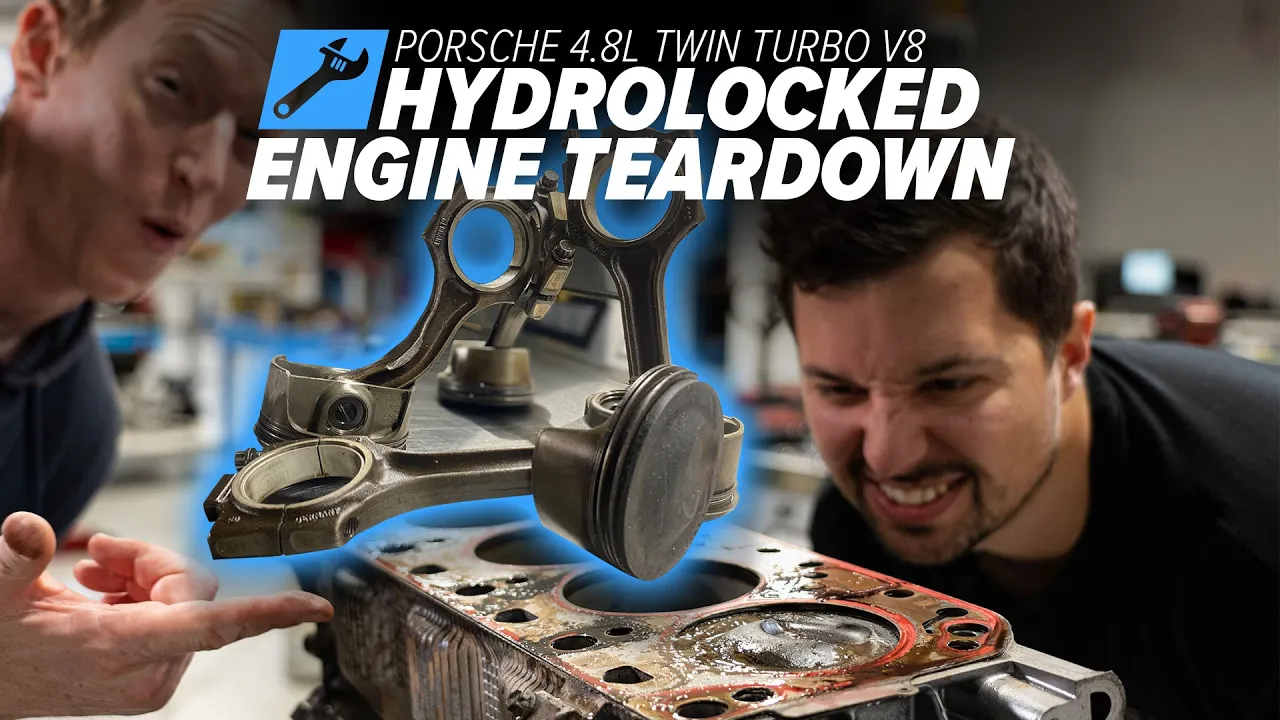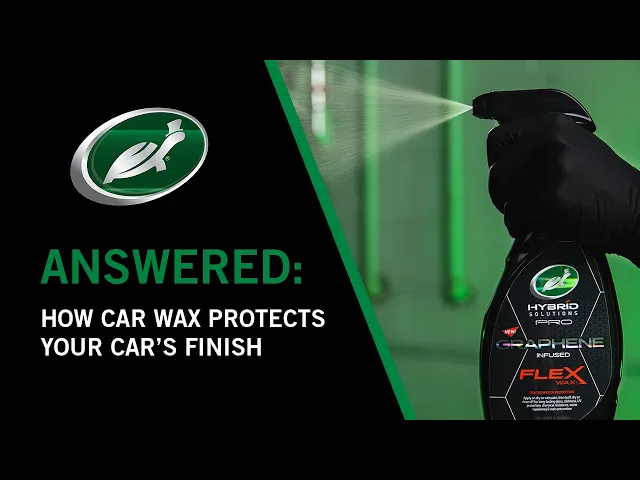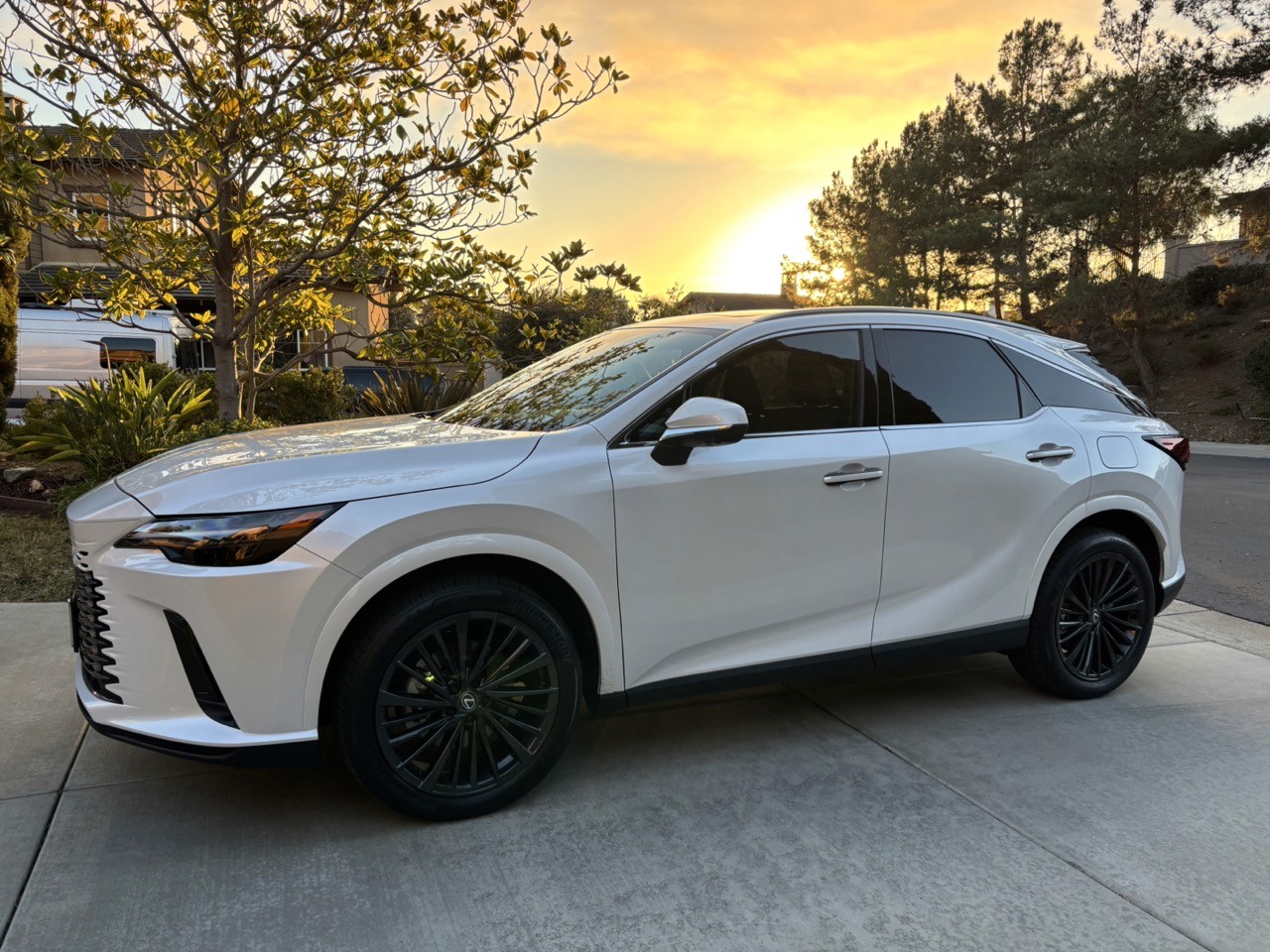
Understanding Hydrolocking: The Silent Engine Killer
Written By
Lewis C. Smith
Published
Oct 1, 2023

FCP Euro. (2022, November 2). Bending steel with water: inside a hydrolocked Porsche engine [Video]. YouTube. https://www.youtube.com/watch?v=Sz9_JMq2zSY
Discover the silent engine killer: hydrolocking. Learn how this issue can devastate your engine and how to prevent it. Explore more at CarOracle.
What is Hydrolocking?
Hydrolocking, short for hydrostatic locking, transpires when water invades an engine's cylinders. While engines are marvels of mechanical design built to compress air-fuel mixtures, they falter against the incompressibility of water. This incompressibility is where the danger lies.
The Science of Incompressibility
Air, mixed with fuel, is easily compressed in the combustion chamber, facilitating the combustion process that powers vehicles. Water, however, doesn't play by these rules. Its molecules, tightly bound, resist compression. When an engine's piston attempts to compress a cylinder filled with water, it's akin to trying to compress a steel block. The immense pressure created by this unyielding resistance can damage internal engine components.
The Perils of Hydrolocking
Bent or Broken Connecting Rods: The instant resistance from water often results in bent or snapped connecting rods, the very links that join pistons to the crankshaft.
Damaged Pistons & Rings: Pistons and their accompanying rings aren't spared either. The sudden stop can lead to fractures and malfunctions.
Blown Head Gasket: The undue pressure can breach the engine's head gasket, a vital sealing component.
Compromised Crankshaft & Bearings: The abrupt halt can stress the crankshaft and associated bearings.
Overstrained Starter Motor: Repeated ignition attempts during a hydrolock can burn out the starter motor.
Exhaust Back Pressure: If a vehicle's tailpipe is submerged, the exhaust gases can't exit. This back pressure further exacerbates the engine's stress, making ignition even more challenging.
Origins of Hydrolocking
Driving Through Floods: The most common culprit. Engines inadvertently gulp water when vehicles traverse deep puddles or flooded terrains.
Maintenance Mishaps: Overzealous engine cleaning or improper servicing might introduce excessive liquids.
Coolant Intrusion: A failing head gasket or a fractured block might allow coolant to seep into the combustion chamber.
An Ounce of Prevention
Avoidance remains the best defense against hydrolocking. Consider the following:
Steer Clear of Deep Water: Unknown depths? Best not to venture.
Mind Your Air Intake: Off-roaders and adventurers, take note. Some vehicles boast elevated air intakes, almost snorkel-like, reducing the hydrolocking risk. If frequenting waterlogged terrains, knowing your engine's air intake position is pivotal.
Act Swiftly: Suspect water ingestion? Do not re-ignite. Expel water by removing spark plugs and cranking the engine. Consult a trusted mechanic immediately.
Conclusion
In summation, hydrolocking is an engine's silent adversary, capable of catastrophic damage. Awareness and judicious driving can mean the difference between a thrilling drive and a stalled engine. For those who treasure their vehicles, understanding and preventing hydrolocking isn't just a recommendation—it's a mandate.
ON THIS PAGE
Vehicle Longevity FAQs
What's the right interval for changing transmission fluid and why is it important for my vehicle's longevity?
Transmission fluid serves multiple purposes in your vehicle. It lubricates moving parts, acts as a hydraulic fluid, and aids in cooling. Therefore, keeping your transmission fluid fresh is important for the performance and longevity of your vehicle's transmission, which is one of the most critical and expensive components of your vehicle.
However, the recommended frequency for changing transmission fluid varies greatly. This is a topic of ongoing debate among automotive professionals. The right interval for changing transmission fluid can depend on many factors, including the vehicle's make and model, the type of transmission (automatic or manual), and how the vehicle is used.
It's essential for vehicle owners to research their specific vehicle and understand the recommended maintenance intervals. This information can often be found in your vehicle's owner's manual or maintenance guide. If there's any uncertainty, it's advisable to consult with a trusted mechanic or your local vehicle dealership. They can provide guidance based on their experience and your vehicle's specific circumstances.
Maintaining the right intervals for changing transmission fluid can help you prevent expensive repairs down the line. Regular maintenance will ensure that your transmission operates smoothly, contributing to your vehicle's overall longevity while keeping your maintenance budget in check.
What's the right interval for changing transmission fluid and why is it important for my vehicle's longevity?
Transmission fluid serves multiple purposes in your vehicle. It lubricates moving parts, acts as a hydraulic fluid, and aids in cooling. Therefore, keeping your transmission fluid fresh is important for the performance and longevity of your vehicle's transmission, which is one of the most critical and expensive components of your vehicle.
However, the recommended frequency for changing transmission fluid varies greatly. This is a topic of ongoing debate among automotive professionals. The right interval for changing transmission fluid can depend on many factors, including the vehicle's make and model, the type of transmission (automatic or manual), and how the vehicle is used.
It's essential for vehicle owners to research their specific vehicle and understand the recommended maintenance intervals. This information can often be found in your vehicle's owner's manual or maintenance guide. If there's any uncertainty, it's advisable to consult with a trusted mechanic or your local vehicle dealership. They can provide guidance based on their experience and your vehicle's specific circumstances.
Maintaining the right intervals for changing transmission fluid can help you prevent expensive repairs down the line. Regular maintenance will ensure that your transmission operates smoothly, contributing to your vehicle's overall longevity while keeping your maintenance budget in check.
What's the right interval for changing transmission fluid and why is it important for my vehicle's longevity?
Transmission fluid serves multiple purposes in your vehicle. It lubricates moving parts, acts as a hydraulic fluid, and aids in cooling. Therefore, keeping your transmission fluid fresh is important for the performance and longevity of your vehicle's transmission, which is one of the most critical and expensive components of your vehicle.
However, the recommended frequency for changing transmission fluid varies greatly. This is a topic of ongoing debate among automotive professionals. The right interval for changing transmission fluid can depend on many factors, including the vehicle's make and model, the type of transmission (automatic or manual), and how the vehicle is used.
It's essential for vehicle owners to research their specific vehicle and understand the recommended maintenance intervals. This information can often be found in your vehicle's owner's manual or maintenance guide. If there's any uncertainty, it's advisable to consult with a trusted mechanic or your local vehicle dealership. They can provide guidance based on their experience and your vehicle's specific circumstances.
Maintaining the right intervals for changing transmission fluid can help you prevent expensive repairs down the line. Regular maintenance will ensure that your transmission operates smoothly, contributing to your vehicle's overall longevity while keeping your maintenance budget in check.
What is a timing belt, and why is its maintenance important for my engine's health?
The timing belt plays a key role in many vehicles' engines. Unlike the serpentine belt, which powers external engine parts like the alternator and air conditioning compressor, the timing belt ensures the crankshaft and the camshaft(s) rotate in unison. This synchronization is necessary for your engine's valves to open and close at the right moments during each cylinder's intake and exhaust strokes.
While some contemporary vehicles use timing chains that often last as long as the engine itself, many vehicles still utilize timing belts. These belts need replacement at specified intervals recommended by the vehicle manufacturer - generally between 60,000 to 100,000 miles or at certain age intervals.
Overlooking the recommended replacement intervals for the timing belt can lead to significant engine damage. If the timing belt breaks, the camshaft stops, leaving some valves open. Consequently, the piston can strike these open valves, leading to substantial damage to the engine's inner components.
So, keeping up with your vehicle's recommended maintenance schedule for timing belt replacement is fundamental. You can locate this information in your vehicle's owner's manual or maintenance guide. If you're uncertain, seek advice from a trusted mechanic or your local vehicle dealership. By maintaining your timing belt, you safeguard your engine from potentially expensive and extensive damage, promoting your vehicle's longevity.
What is a timing belt, and why is its maintenance important for my engine's health?
The timing belt plays a key role in many vehicles' engines. Unlike the serpentine belt, which powers external engine parts like the alternator and air conditioning compressor, the timing belt ensures the crankshaft and the camshaft(s) rotate in unison. This synchronization is necessary for your engine's valves to open and close at the right moments during each cylinder's intake and exhaust strokes.
While some contemporary vehicles use timing chains that often last as long as the engine itself, many vehicles still utilize timing belts. These belts need replacement at specified intervals recommended by the vehicle manufacturer - generally between 60,000 to 100,000 miles or at certain age intervals.
Overlooking the recommended replacement intervals for the timing belt can lead to significant engine damage. If the timing belt breaks, the camshaft stops, leaving some valves open. Consequently, the piston can strike these open valves, leading to substantial damage to the engine's inner components.
So, keeping up with your vehicle's recommended maintenance schedule for timing belt replacement is fundamental. You can locate this information in your vehicle's owner's manual or maintenance guide. If you're uncertain, seek advice from a trusted mechanic or your local vehicle dealership. By maintaining your timing belt, you safeguard your engine from potentially expensive and extensive damage, promoting your vehicle's longevity.
What is a timing belt, and why is its maintenance important for my engine's health?
The timing belt plays a key role in many vehicles' engines. Unlike the serpentine belt, which powers external engine parts like the alternator and air conditioning compressor, the timing belt ensures the crankshaft and the camshaft(s) rotate in unison. This synchronization is necessary for your engine's valves to open and close at the right moments during each cylinder's intake and exhaust strokes.
While some contemporary vehicles use timing chains that often last as long as the engine itself, many vehicles still utilize timing belts. These belts need replacement at specified intervals recommended by the vehicle manufacturer - generally between 60,000 to 100,000 miles or at certain age intervals.
Overlooking the recommended replacement intervals for the timing belt can lead to significant engine damage. If the timing belt breaks, the camshaft stops, leaving some valves open. Consequently, the piston can strike these open valves, leading to substantial damage to the engine's inner components.
So, keeping up with your vehicle's recommended maintenance schedule for timing belt replacement is fundamental. You can locate this information in your vehicle's owner's manual or maintenance guide. If you're uncertain, seek advice from a trusted mechanic or your local vehicle dealership. By maintaining your timing belt, you safeguard your engine from potentially expensive and extensive damage, promoting your vehicle's longevity.
Does regularly washing my car affect its longevity?
Yes, regular car washing can contribute to your vehicle's longevity in a few significant ways. Most obviously, washing your car helps maintain its appearance, making the driving experience more enjoyable and preserving the vehicle's resale value.
However, regular washing has other, less visible benefits. Over time, dirt, dust, bird droppings, and other contaminants can damage your vehicle's paint, leading to rust and corrosion. In colder climates where roads are salted during the winter, this effect can be even more pronounced. Salt can get into small crevices and chip away at your vehicle's protective coating, accelerating the rusting process. Regular washing, particularly in winter, helps remove this salt and reduce the risk of rust and corrosion.
Cleaning the interior is also beneficial. Dust and dirt can wear down upholstery over time, and spilled liquids can cause stains or foul odors. Regularly cleaning the interior of your vehicle keeps it looking and smelling fresh, preserving the integrity of the materials and potentially increasing your vehicle’s longevity.
In short, consider regular washing and interior cleaning as part of your vehicle's maintenance routine. It's a relatively small investment of time and effort that can pay off in terms of increased vehicle longevity and resale value.
Does regularly washing my car affect its longevity?
Yes, regular car washing can contribute to your vehicle's longevity in a few significant ways. Most obviously, washing your car helps maintain its appearance, making the driving experience more enjoyable and preserving the vehicle's resale value.
However, regular washing has other, less visible benefits. Over time, dirt, dust, bird droppings, and other contaminants can damage your vehicle's paint, leading to rust and corrosion. In colder climates where roads are salted during the winter, this effect can be even more pronounced. Salt can get into small crevices and chip away at your vehicle's protective coating, accelerating the rusting process. Regular washing, particularly in winter, helps remove this salt and reduce the risk of rust and corrosion.
Cleaning the interior is also beneficial. Dust and dirt can wear down upholstery over time, and spilled liquids can cause stains or foul odors. Regularly cleaning the interior of your vehicle keeps it looking and smelling fresh, preserving the integrity of the materials and potentially increasing your vehicle’s longevity.
In short, consider regular washing and interior cleaning as part of your vehicle's maintenance routine. It's a relatively small investment of time and effort that can pay off in terms of increased vehicle longevity and resale value.
Does regularly washing my car affect its longevity?
Yes, regular car washing can contribute to your vehicle's longevity in a few significant ways. Most obviously, washing your car helps maintain its appearance, making the driving experience more enjoyable and preserving the vehicle's resale value.
However, regular washing has other, less visible benefits. Over time, dirt, dust, bird droppings, and other contaminants can damage your vehicle's paint, leading to rust and corrosion. In colder climates where roads are salted during the winter, this effect can be even more pronounced. Salt can get into small crevices and chip away at your vehicle's protective coating, accelerating the rusting process. Regular washing, particularly in winter, helps remove this salt and reduce the risk of rust and corrosion.
Cleaning the interior is also beneficial. Dust and dirt can wear down upholstery over time, and spilled liquids can cause stains or foul odors. Regularly cleaning the interior of your vehicle keeps it looking and smelling fresh, preserving the integrity of the materials and potentially increasing your vehicle’s longevity.
In short, consider regular washing and interior cleaning as part of your vehicle's maintenance routine. It's a relatively small investment of time and effort that can pay off in terms of increased vehicle longevity and resale value.
Does regular maintenance really extend the life of a car?
Absolutely! Regular maintenance is one of the most effective ways to extend the lifespan of your vehicle and ensure it continues to perform optimally. Maintenance tasks like oil changes, tire rotations, brake inspections, fluid checks, and filter replacements are all essential to keeping your vehicle in good running order. They help prevent more significant, more expensive problems down the road by addressing small issues before they escalate.
Moreover, regular maintenance can enhance your vehicle's fuel efficiency, safety, and reliability, offering you a smoother and safer ride. Your owner's manual or maintenance guide will provide a schedule of recommended maintenance intervals for various services. It's crucial for vehicle owners to maintain familiarity with and adherence to these guidelines.
Neglecting routine maintenance can lead to the premature failure of critical components, which can be costly to repair and may significantly decrease your vehicle's lifespan. So, make it a habit to keep up with your car's maintenance schedule - your vehicle (and your wallet) will thank you for it!
Does regular maintenance really extend the life of a car?
Absolutely! Regular maintenance is one of the most effective ways to extend the lifespan of your vehicle and ensure it continues to perform optimally. Maintenance tasks like oil changes, tire rotations, brake inspections, fluid checks, and filter replacements are all essential to keeping your vehicle in good running order. They help prevent more significant, more expensive problems down the road by addressing small issues before they escalate.
Moreover, regular maintenance can enhance your vehicle's fuel efficiency, safety, and reliability, offering you a smoother and safer ride. Your owner's manual or maintenance guide will provide a schedule of recommended maintenance intervals for various services. It's crucial for vehicle owners to maintain familiarity with and adherence to these guidelines.
Neglecting routine maintenance can lead to the premature failure of critical components, which can be costly to repair and may significantly decrease your vehicle's lifespan. So, make it a habit to keep up with your car's maintenance schedule - your vehicle (and your wallet) will thank you for it!
Does regular maintenance really extend the life of a car?
Absolutely! Regular maintenance is one of the most effective ways to extend the lifespan of your vehicle and ensure it continues to perform optimally. Maintenance tasks like oil changes, tire rotations, brake inspections, fluid checks, and filter replacements are all essential to keeping your vehicle in good running order. They help prevent more significant, more expensive problems down the road by addressing small issues before they escalate.
Moreover, regular maintenance can enhance your vehicle's fuel efficiency, safety, and reliability, offering you a smoother and safer ride. Your owner's manual or maintenance guide will provide a schedule of recommended maintenance intervals for various services. It's crucial for vehicle owners to maintain familiarity with and adherence to these guidelines.
Neglecting routine maintenance can lead to the premature failure of critical components, which can be costly to repair and may significantly decrease your vehicle's lifespan. So, make it a habit to keep up with your car's maintenance schedule - your vehicle (and your wallet) will thank you for it!
Do regular oil changes affect the longevity of a car?
Yes, for Internal Combustion Engine (ICE) vehicles, regular oil changes are crucial for maintaining the longevity of a car. The engine oil lubricates the engine's moving parts, reducing friction, carrying away heat, and minimizing wear on the engine components that are moving upwards of thousands of times in a minute. Over time, the oil can break down, losing its viscosity or thickness and therefore reducing its ability to protect your engine. This can lead to premature engine wear and potential failure.
Regular oil changes, according to the maintenance intervals recommended in your owner's manual or maintenance guide, help ensure that your engine is always lubricated with clean, high-quality oil, thereby increasing the lifespan of your vehicle. It's also important to regularly check your oil level in between oil changes to ensure your vehicle isn't running low on oil.
Your owner's manual will provide instructions on how to check your oil level and how to add oil. Always remember to use the correct oil grade for your vehicle for optimal performance. If you have questions about your particular car, consider reaching out to a trusted mechanic or a local dealer for your vehicle. Maintaining familiarity with and adherence to the recommended maintenance intervals for oil changes and other routine services in your manual is key to preserving the longevity and performance of your car.
Do regular oil changes affect the longevity of a car?
Yes, for Internal Combustion Engine (ICE) vehicles, regular oil changes are crucial for maintaining the longevity of a car. The engine oil lubricates the engine's moving parts, reducing friction, carrying away heat, and minimizing wear on the engine components that are moving upwards of thousands of times in a minute. Over time, the oil can break down, losing its viscosity or thickness and therefore reducing its ability to protect your engine. This can lead to premature engine wear and potential failure.
Regular oil changes, according to the maintenance intervals recommended in your owner's manual or maintenance guide, help ensure that your engine is always lubricated with clean, high-quality oil, thereby increasing the lifespan of your vehicle. It's also important to regularly check your oil level in between oil changes to ensure your vehicle isn't running low on oil.
Your owner's manual will provide instructions on how to check your oil level and how to add oil. Always remember to use the correct oil grade for your vehicle for optimal performance. If you have questions about your particular car, consider reaching out to a trusted mechanic or a local dealer for your vehicle. Maintaining familiarity with and adherence to the recommended maintenance intervals for oil changes and other routine services in your manual is key to preserving the longevity and performance of your car.
Do regular oil changes affect the longevity of a car?
Yes, for Internal Combustion Engine (ICE) vehicles, regular oil changes are crucial for maintaining the longevity of a car. The engine oil lubricates the engine's moving parts, reducing friction, carrying away heat, and minimizing wear on the engine components that are moving upwards of thousands of times in a minute. Over time, the oil can break down, losing its viscosity or thickness and therefore reducing its ability to protect your engine. This can lead to premature engine wear and potential failure.
Regular oil changes, according to the maintenance intervals recommended in your owner's manual or maintenance guide, help ensure that your engine is always lubricated with clean, high-quality oil, thereby increasing the lifespan of your vehicle. It's also important to regularly check your oil level in between oil changes to ensure your vehicle isn't running low on oil.
Your owner's manual will provide instructions on how to check your oil level and how to add oil. Always remember to use the correct oil grade for your vehicle for optimal performance. If you have questions about your particular car, consider reaching out to a trusted mechanic or a local dealer for your vehicle. Maintaining familiarity with and adherence to the recommended maintenance intervals for oil changes and other routine services in your manual is key to preserving the longevity and performance of your car.
Dive Even Deeper into Vehicle Longevity
Dive Even Deeper into Vehicle Longevity
Dive Even Deeper into Vehicle Longevity
Latest Insights
Latest Insights
Latest Insights
Load more
Load more
Load more
CarOracle is a California-licensed automotive dealer, License No: 43082, with an autobroker's endorsement, enabling us to represent consumers in the purchase or leasing of new and used vehicles.
Schedule a Consultation
Our Service Areas
Get in touch
©2025 CarOracle. All rights reserved
CarOracle is a California-licensed automotive dealer, License No: 43082, with an autobroker's endorsement, enabling us to represent consumers in the purchase or leasing of new and used vehicles.
Schedule a Consultation
Our Service Areas
Get in touch
©2025 CarOracle. All rights reserved
CarOracle is a California-licensed automotive dealer, License No: 43082, with an autobroker's endorsement, enabling us to represent consumers in the purchase or leasing of new and used vehicles.
Schedule a Consultation
Our Service Areas
Get in touch
©2025 CarOracle. All rights reserved














